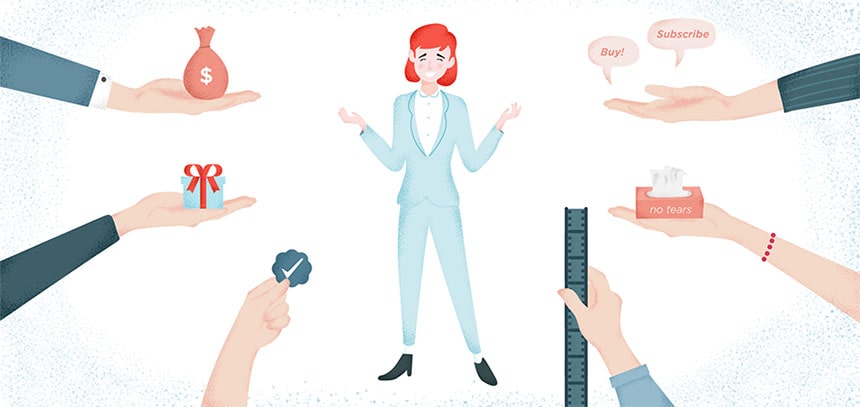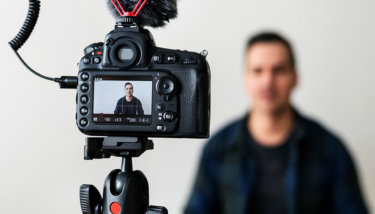Video testimonials are powerful pieces of marketing content—but filming testimonials is difficult. There are a lot of things to think about. Will your viewers connect with the person giving the testimonial? Are they saying the right things that will encourage sales? Have you added the right things in post-production?
Answering these questions is crucial to creating an effective video testimonial. But if you’ve never done it before, you’re going to need some help.
The following six things are essential for creating a high-quality, professional video testimonial. You should always try to create your own style, but if you can incorporate these factors into your testimonial, it will be a great tool for landing customers.
1. A Relatable, Believable Customer
Have you ever seen a video testimonial with a customer that looks like they’re reading from a script the whole time? It’s painful. It takes you out of the flow of the testimonial and makes it difficult to focus on what they’re saying. It makes it hard to connect with the speaker.
A video testimonial is all about getting the viewer to connect with the subject. And if your customer isn’t relatable or believable, that’s not going to happen. Unfortunately, there are a lot of easy-to-make mistakes that reduce the believability of your customer.
To keep this from happening, do everything you can to make your subject comfortable. Keep the conversation casual, like you’re chatting with a friend. Take this FreshBooks customer for example. Her laugh and gestures make it clear that she’s chatting casually:
Click here to watch the video -> youtube.com/watch?v=bZEvZKtJlwQ
Avoid scripting your questions and—even more importantly—the answers. You can always edit things out and recombine sections later.
(And you should have some idea of what you’re going to ask; we’ll talk about that in the next point.)
Let your customer be themselves. There’s no need to try to get them to say anything specific. If they love your product or service enough to film a testimonial, they’re going to say the things you want them to say.
Most importantly, remember that the testimonial is about your customer, not your brand. Getting your customer to talk about how your product or service helped them overcome a problem or improve their lives creates an emotional connection that makes for a great testimonial.
Give your customer time to talk about their own brand and introduce themselves. When viewers see that they’re watching a real person, working at a real company, solving real problems, they’ll connect to the testimonial and get more out of it.
In the end, a believable customer is the result of a relaxed conversation. Put everyone at ease and chat with them about their business, their problems, and the solutions.
2. A Main Point
“Why should I care? What’s in it for me?”
If your testimonial doesn’t answer these questions, you’re going to lose viewers fast.
While it might be tempting to have your customer talk about many different features and benefits in your testimonial video, make sure to keep it short. Each testimonial should have one main point.
Maybe the point is that your product helped someone meet their life goals. Or that your service helped a business spend less on HR and onboarding. Or even something smaller: maybe your product or service made it easier to maintain a functional contacts list.
Whatever the main point is, be sure to focus on it. Having your customer share a story or two on the topic is a great way to do this (and is great for generating an emotional connection, which we’ll talk about next).
MileIQ’s short but effective testimonial focuses on tax deductions:
Click here to watch the video -> youtube.com/watch?v=KGlB66Qk8I0
The more you can hone in on a main point, the more effective your testimonial will be. Of course, you’ll want to connect that to the wider picture of what your company can do for a customer. But most of the testimonial should focus on one particular problem or benefit.
While you shouldn’t script your interview, it’s a good idea to have an idea of what your main point will be before you get started. If you chose a customer for a video testimonial, you probably know how they used your product or service and what benefits they received. You can use that information to get an idea of what your main point will be.
3. An Emotional Hook
The very best testimonials take us on an emotional journey. They with frustration, stress, and confusion. They move through discovery and hope. Then they get to relief, satisfaction, and fulfillment. All in a couple minutes.
If your video testimonial can take viewers on this journey with your customer, you’ve created a perfect marketing tool. People respond to emotions—in fact, people seeing others’ emotions actually feel those same emotions. Which means they develop an emotional connection to both your customer and your brand.
But to develop that connection, your subject needs to talk about their own emotions. Finding the right way to approach this isn’t always easy. You need to get your subject to talk about how they felt before they found your product or service and how they feel now. As we talked about before, this is supposed to be a casual conversation—so you’ll need to work on questions about these emotions without forcing it.
Instead, you’ll need to ask the subject about their pain points. What troubles were they having before they found your company? What problems couldn’t they find a solution to? What other solutions did they try before they started using your product or service? They’re almost certainly the same pain points as your viewers will be feeling.
And that helps your viewers build that invaluable emotional connection to your subject.
This customer felt distanced from her family, and was able to reconnect via a print-on-demand service:
Click here to watch the video -> youtube.com/watch?v=ZjFkXAgCjMc
Work a negative emotion and a positive one into the main point of your testimonial. If you can frame the entire thing around an idea like “I was frustrated because my accounting software was so complicated, and now, with this new software, I can run my business in a way that gives me more control over my life,” you have a winner on your hands.
Notice that “more control over my life” isn’t a feature of the accounting software—it’s a benefit of using it. Let’s talk about that more.
4. Benefits, Not Features
This is one of the core ideas of successful marketing: sell benefits, not features. Especially in today’s fast-moving world, where new products and services show up all the time, it’s difficult to always stay ahead on features. And customers don’t have any sort of emotional response to “made from high-grade ballistic nylon.”
They do, however, have an emotional response to “stop worrying about rips in your luggage.” That’s a benefit, not a feature.
Not all of the benefits of your product or service need to be connected back to a specific emotion. Many of them are related to how we see ourselves. Using the ballistic nylon luggage example, a customer might say “I’m a smart purchaser because I bought a bag that lasts a long time.”
Take this Habitat for Humanity video for example. Amanda talks about her kids having their own space—she doesn’t talk about the number of rooms in the house:
Click here to watch the video -> youtube.com/watch?v=-VrOWRPP6Uc
There are certainly benefits that don’t have an emotional connotation. A high-quality travel coffee mug keeps your coffee hot longer. That’s not a feature, it’s a benefit—but it probably won’t elicit an emotional response.
Focusing on benefits instead of features helps potential customers see how their lives will be better after buying your product or service. And in a video testimonial, it’s important to focus on those benefits. If your subject is just listing the features of your product or service, viewers could stop the video and go back to your website.
It’s seeing someone they can relate to talking about how their lives are better that drives successful video testimonials.
5. Text + Graphics
While most of your video testimonial should consist of your subject talking, you can tastefully highlight some of what they’re saying with text or graphics. You can also call out specific figures that make an impact. Even small highlights can make a big difference.
Why do this at all? It’s beneficial largely because it helps create visual interest. If your video testimonial isn’t visually interesting, it’s going to be harder to pay attention to. But with well-done text and graphics, a video becomes much more interesting.
Adding text also has the advantage of appealing to a wider range of viewers. While many people learn well and retain information from audiovisual presentations, some are better at absorbing information if they read it. This way you appeal to both.
In this testimonial from I Will Teach You to Be Rich, text is used to segment the video into manageable sections:
Click here to watch the video -> youtube.com/watch?v=OZ7DpUUDgIo
If you’re going to share your video testimonial on social media, you definitely want to add at least some text. Many people watch videos on social media without sound, and if you can catch their attention with text or graphics, there’s a better chance they’ll take the time to watch the video.
Be careful not to overdo it. The main focus should be on your subject. Text and graphics simply serve to drive home an important point.
6. B-Roll
Even with text and graphics, viewers aren’t going to want to watch a single shot of someone talking for several minutes. You’re going to need more than that to keep their interest, even if the video is less than five minutes long (which it should be).
That’s where B-roll comes in. This is the footage that you’ll cut into the main shot from time to time to create some variety or emphasize a point.
So what kind of B-roll should you have? At the very least, you should set up a second camera off to the side, so you can intersperse shots from a different angle. The main angle should be your customer looking into the camera, but the other can show them talking from an angle.
If you can get footage of the customer actually going through their day and using your product, even better! That adds believability and gives your viewers a look into what it’s actually like to use your product or service.
Amazon Fulfillment does a great job of blending interview-like footage with B-roll in this testimonial:
Click here to watch the video -> youtube.com/watch?v=x5Gk0pufiCU
B-roll should make up a small portion of your video, but it can make a big difference in adding a professional air to your testimonial. It’s not always easy to get high-quality B-roll if you’re new to the video production scene, which is why it might be helpful to bring on someone who has experience in this type of filming.
Either way, though, make a point to vary what you’re showing on the screen during your testimonial.
Combine These Elements for Video Testimonial Success
A great video testimonial is driven by a great customer story. If your subject has a story to tell about how your product or service improved their life or their business, you’re set. But if you can include all six of these elements in your testimonial, you’ll have an absolute winner.
And if you’re not convinced yet that you should be making a video testimonial at all, check out these X reasons that they make fantastic marketing tools!



